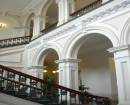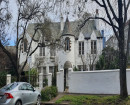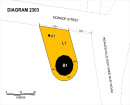ESSENDON RAILWAY STATION COMPLEX
2-16 RUSSELL STREET AND 29-31 ROSE STREET AND BUCKLEY STREET ESSENDON, MOONEE VALLEY CITY
-
Add to tour
You must log in to do that.
-
Share
-
Shortlist place
You must log in to do that.
- Download report






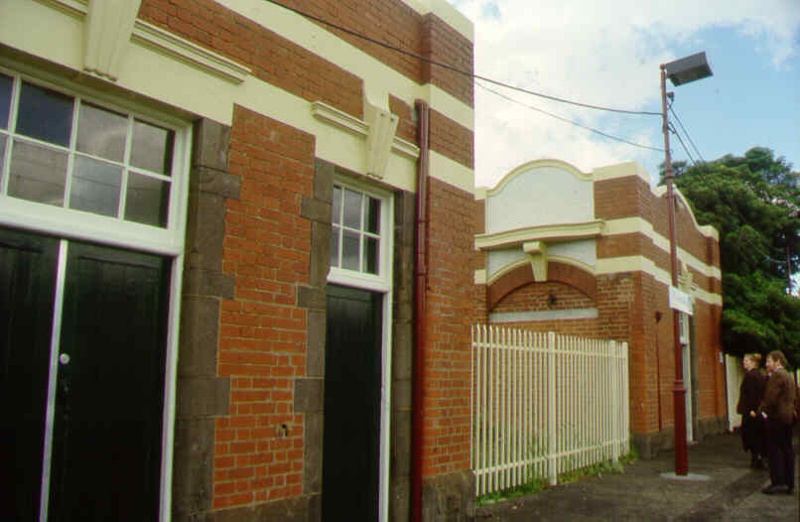
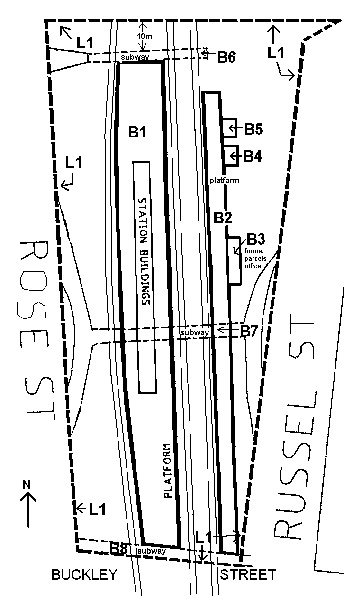
Statement of Significance
The Melbourne to Essendon line opened from Spencer Street to Essendon, in October 1860. One unreliable engine and two carriages conducted an intermittent service between the five stations along the line until its premature closure in July 1864. Regular passenger service resumed under government ownership in 1871. Essendon Railway Station was the terminus for the Melbourne to Essendon Line for approximately twelve years. A completely new station at Essendon was constructed in 1878, erected on the site of the present island platform. Additions in 1886 included the provision of subways and footbridges and the conversion of the 1878 single-faced platform into the island. In 1909 the current centre platform and station building and the lamp room/store complex were constructed on the site. The contractor was A. Challingsworth. In 1922 a red brick parcels office was constructed on the down-side platform. The buildings are in the Federation Free Classical Style. The complex consists of a centre platform accessed via a subway and with a station building containing a ticket office, waiting rooms and toilets. The ramp to this platform is covered with a timber canopy and is supported on short cast iron columns filled with concrete. The platform off Russell Street contains a former lamp room/milk shed complex and the 1922 parcels office. The buildings are in red brick with rough cast stucco above door and window height. Details include ornate parapets and cantilever verandahs to the platforms, and bluestone quoin work around the openings. The cantilever verandahs are clad in corrugated iron sheet and faced with a ripple iron valance
Essendon Railway Station Complex is of architectural, aesthetic, social and historical importance to the State of Victoria.
Essendon Railway Station Complex is of architectural and aesthetic significance as an excellent intact example of a Federation Free Style design station with elaborate detailing. Details include the ornate parapets, bluestone quoining around the openings, windows with multi pane coloured glass in the upper sash, cement banding and keystone motifs above the openings. The station is unusual as it includes an intact example of a van goods shed/lamp room/milk shed/store complex. This is unique for this particular style of station buildings. The complex is important as the precursor of a group of stations constructed by the Victorian Railways Department between 1909 an 1922 and is thought to be the most representative of this style, containing all of its typical elements and presenting them in a manner consistent with the style. The cast iron columns filled with concrete, used to support the ramp to the centre platform are an innovative method of construction. The buildings also demonstrate the early use of reinforced concrete as it was used to form lintels, slabs to floors and ramps.
Essendon Railway Station Complex is of social and historical importance for its ability to demonstrate the expansion of Melbourne and settlement of the suburbs after the turn of the century. The construction of an upgraded station in 1909 represents a boom period in the history of Essendon. The complex is important for its potential to yield information on the changing nature of railways, locomotive technology and transport use in Victoria.
-
-
ESSENDON RAILWAY STATION COMPLEX - History
The Essendon Style
This group is one of several designed to provide improved, and occasionally additional, facilities at important locations on the network. The majority of examples are situated in the metropolitan area, for it is here that traffic growth was most intense.
Melbourne-Bendigo/ Castlemaine; island platform building
Melbourne-Lilydale/ Box Hill - island platform; side platform and porters/lamp room buildings.
Melbourne-Broadmeadows/ Essendon; island platform, side platform and store/yard/lamp room buildings.
Melbourne-Hurstbridge/ Heidelberg; island platform and porters/lamp room buildings.
Melbourne-Orbost/Caulfield; island platform, toilets and two side platform buildings.
Oakleigh; island platform, and side platform buildings
Warragul; island platform building
Melbourne-Williamstown/ Spotswood; two side platform buildings
This style blossomed around 1910 and was extinguished sharply by the outbreak of the First World War. Reinforced concrete was emerging at this time as a useful building material and it was used in these stations to form lintels and slabs to floors and ramps. The slab soffits at Essendon are finished with cement rough cast and 60lb rails are substituted for reinforcing bars.
The plan form consists typically of an island platform building, accessible via a pedestrian ramp and subway, and a secondary building handling passenger and parcels traffic on a side platform with road access. The main building, located at the head of the ramp, consists of the station master’s office, backing onto the general waiting room, then the ladies waiting room, ladies toilet and finally, the men’s toilets. The plan of the secondary building varied.
The principal features of the facade were classical, presented in an Edwardian manner. They included Romanesque archways and segmentally arched windows, circular and triangular pediments and cornices, - at Caulfield, and keystone motifs over windows, and archways. Other details, by which this style can be quickly recognised, include cement render banding, terminating in a radiating design around the archways, and the use of cement roughcast in conjunction with glazed olive green tiles forming parapets above the verandah line. The windows are frequently formed by large Romanesque arches with multi-pane upper sashes.
The picturesque roof line, characteristic of Edwardian Style buildings, was achieved by means of an undulating parapet motif above the line of the cantilever awning. It was complemented by the arched windows and openings, linked together with vestigial cornices. Inside, the linings were either vee-jointed timber or pressed sheet metal featuring spidery “art nouveau” patterns.
At Essendon, the red brickwork was further relieved with bluestone quoining at the doorways - a throw back to the Footscray Style. It is probably the most representative example of the group, containing all of its typical elements and presenting them in a manner consistent with the style .
History of Place:
Essendon to Melbourne Railway
Built by a private company (Melbourne and Essendon Railway Co.) which included brewer, Peter McCracken, Hugh Glass and Edward Byam Wight of Kensington, it opened from Spencer Street to Essendon, in October 1860 .
One unreliable engine and two carriages conducted an intermittent service between the five stations along the line until its premature closure, three and a half years later, in July 1864. Returns had not covered the costs, among which was the rental payed to the government for use of the public line from North Melbourne to Spencer Street .
The spur line of 1867 from Newmarket to Flemington Race Course replaced a footway from that station and was judged in 1863 to be the only means for the railway’s survival. Regular passenger service resumed under government ownership in 1871 and the Newmarket Stock Saleyards were benefited by extensive railway stock yards, built west of Newmarket Station. This allowed the eventual extension of the line into New South Wales by the end of 1873. Duplication followed in 1881, down side platforms were rebuilt in 1908, and the first electrification of any running line in Australia occurred during 1914-15. The first test runs in the preparation for electrification were made on the racecourse spur line, whilst the first electric train to carry passengers on an Australian railway did so to the recently rebuilt Essendon station on the 28th May 1919.
As the first terminus for twelve years and the probable possessor of the first station on the line (1878). Essendon retains little of the early period and has instead given its name to a style of island platform stations, as its first example. A Challingsworth constructed most of the lines now downside stations in 1908 and commenced Essendon in 1909, building the island platform and station. Coates Bros. completed the upside station in that year .
Essendon received a completely new station in 1878, erected on the site of the present island platform. Additions in 1886 included the provision of subways and footbridges and the conversion of the 1878 single-faced platform into the island. Further alterations were made in 1909, including the construction of the current station buildings. At this time a centre through track between the two platform roads was also provided. This was removed in November 1969, when further alterations were made to the station, including the replacement of the interlocked gates at the Buckley Street level crossing with boom barriers, and the abolition of the lofty signal-box.
The extension of the railway beyond Essendon crossed the Mount Alexander Road a short distance north of the station. Originally this crossing was on the level with hand-operated gates protecting road traffic from passing trains. In 1886 the roadway was lowered and taken under the railway. This very early grade separation project was carried out by the well known contracting firm of Shaw and Dunlop. The underpass was widened to its present proportions in 1931 .
A parcels office was added to the upside buildings around 1922. The milk shed has been converted into a van goods shed. Minor internal changes have occurred over the years resulting in the bricking up of some openings. The decorative details of this complex remain intact.
A very important example of its group, this building features the standard island platform building and a van goods shed/milk shed (replaced)/store/lamp room complex which is unique in this group.
Street elevations used a new Baroque style in face brick and stucco, which accentuated parapet arches and their reflections in the semi circular window hoods beneath. Reinforced concrete in the lintels and the bracketed window hoods, distinguish this new style group from previous stations. The Mediterranean (Italian) theme of the architecture at Essendon is supported by the Canary Island Date Palm, adjacent. Ox-bow arched parapets flanked by brick pylons, carry the twin cantilevering skillion verandahs over the island platforms. These were devices used by Chief architect, J. W. Harding in later designs .
Of the typical plan form, one island and an up platform with road access and a subway, Essendon retains most of its original components including the lantern over the ramp, heavy timber wicket gates, and the milkshed (now a van goods shed). Some openings have been bricked in and a porch shelter added to the north end of the up station buildings .
The station has been identified in Andrew Ward’s study as being part of the Essendon style group. This group is one of several, designed to provide improved, and occasionally additional, facilities at important locations on the network. The majority of examples are situated in the metropolitan area, for it is here that traffic growth was most intense.
Associated People:
ESSENDON RAILWAY STATION COMPLEX - Assessment Against Criteria
Criterion A
The historical importance, association with or relationship to Victoria's history of the place or object.
Essendon Railway Complex is of social and historical importance for its ability to demonstrate the expansion of Melbourne and settlement of the suburbs after the turn of the century. The construction of an upgraded station in 1909 represents a boom period in the history of Essendon.
Criterion B
The importance of a place or object in demonstrating rarity or uniqueness.
The van goods shed/lamp room/milk shed/store complex is unique in this Essendon style group.
Criterion C
The place or object's potential to educate, illustrate or provide further scientific investigation in relation to Victoria's cultural heritage.
The complex is important for its potential to yield information on the changing nature of railways, locomotive technology and transport use in Victoria.
Criterion D
The importance of a place or object in exhibiting the principal characteristics or the representative nature of a place or object as part of a class or type of places or objects.
Essendon Railway station is believed to be the best representative example of the Essendon Style Group, demonstrating many of the distinct characteristics common to the style.
Criterion E
The importance of the place or object in exhibiting good design or aesthetic characteristics and/or in exhibiting a richness, diversity or unusual integration of features.
Essendon Railway Station is a particularly intact example of a station building built during a period of upgrading of railway lines in Victoria. It retains much of its original architectural detailing.
Criterion F
The importance of the place or object in demonstrating or being associated with scientific or technical innovations or achievements.Criterion G
The importance of the place or object in demonstrating social or cultural associations.Criterion H
Any other matter which the Council considers relevant to the determination of cultural heritage significanceESSENDON RAILWAY STATION COMPLEX - Permit Exemptions
General Exemptions:General exemptions apply to all places and objects included in the Victorian Heritage Register (VHR). General exemptions have been designed to allow everyday activities, maintenance and changes to your property, which don’t harm its cultural heritage significance, to proceed without the need to obtain approvals under the Heritage Act 2017.Places of worship: In some circumstances, you can alter a place of worship to accommodate religious practices without a permit, but you must notify the Executive Director of Heritage Victoria before you start the works or activities at least 20 business days before the works or activities are to commence.Subdivision/consolidation: Permit exemptions exist for some subdivisions and consolidations. If the subdivision or consolidation is in accordance with a planning permit granted under Part 4 of the Planning and Environment Act 1987 and the application for the planning permit was referred to the Executive Director of Heritage Victoria as a determining referral authority, a permit is not required.Specific exemptions may also apply to your registered place or object. If applicable, these are listed below. Specific exemptions are tailored to the conservation and management needs of an individual registered place or object and set out works and activities that are exempt from the requirements of a permit. Specific exemptions prevail if they conflict with general exemptions. Find out more about heritage permit exemptions here.Specific Exemptions:General Conditions:
1. All exempted alterations are to be planned and carried out in a manner which prevents damage to the fabric of the registered place or object.
2. Should it become apparent during further inspection or the carrying out of alterations that original or previously hidden or inaccessible details of the place or object are revealed which relate to the significance of the place or object, then the exemption covering such alteration shall cease and the Executive Director shall be notified as soon as possible.
3. If there is a conservation policy and plan approved by the Executive Director, all works shall be in accordance with it.
4. Nothing in this declaration prevents the Executive Director from amending or rescinding all or any of the permit exemptions.
5. Nothing in this declaration exempts owners or their agents from the responsibility to seek relevant planning or building permits from the responsible authority where applicable.
Exterior
* Minor repairs and maintenance which replace like with like.
* Removal of any extraneous items such as air conditioners, pipe work, ducting, wiring, antennae, aerials etc, and making good.
* Installation or repair of damp-proofing by either injection method or grouted pocket method.
* Regular garden maintenance.
Interior
* Painting of previously painted walls and ceilings provided that preparation or painting does not remove evidence of the original paint or other decorative scheme.
* Removal of paint from originally unpainted or oiled joinery, doors, architraves, skirtings and decorative strapping.
* Installation, removal or replacement of carpets and/or flexible floor coverings.
* Installation, removal or replacement of curtain track, rods, blinds and other window dressings.
* Installation, removal or replacement of hooks, nails and other devices for the hanging of mirrors, paintings and other wall mounted artworks.
* Refurbishment of bathrooms, toilets including removal, installation or replacement of sanitary fixtures and associated piping, mirrors, wall and floor coverings.
* Installation, removal or replacement of kitchen benches and fixtures including sinks, stoves, ovens, refrigerators, dishwashers etc and associated plumbing and wiring.
* Installation, removal or replacement of ducted, hydronic or concealed radiant type heating provided that the installation does not damage existing skirtings and architraves and provided that the location of the heating unit is concealed from view.
* Installation, removal or replacement of electrical wiring provided that all new wiring is fully concealed and any original light switches, pull cords, push buttons or power outlets are retained in-situ. Note: if wiring original to the place was carried in timber conduits then the conduits should remain in-situ.
* Installation, removal or replacement of bulk insulation in the roof space.
* Installation, removal or replacement of smoke detectors
-
-
-
-
-
LOWTHER HALL ANGLICAN GRAMMAR SCHOOL
 Victorian Heritage Register H0146
Victorian Heritage Register H0146 -
FORMER CURATOR'S COTTAGE
 Victorian Heritage Register H1078
Victorian Heritage Register H1078 -
RESIDENCE
 Victorian Heritage Register H1160
Victorian Heritage Register H1160
-
"1890"
 Yarra City
Yarra City -
"AMF Officers" Shed
 Moorabool Shire
Moorabool Shire -
"AQUA PROFONDA" SIGN, FITZROY POOL
 Victorian Heritage Register H1687
Victorian Heritage Register H1687
-
'Aqua Profonda' sign wall sign, Fitzroy Swimming Pool
 Yarra City H1687
Yarra City H1687 -
'DRIFFVILLE'
 Boroondara City
Boroondara City -
1) WEATHERBOARD FARM HOUSE AND 2) THE OUTBUILDINGS
 Nillumbik Shire
Nillumbik Shire
-
-











